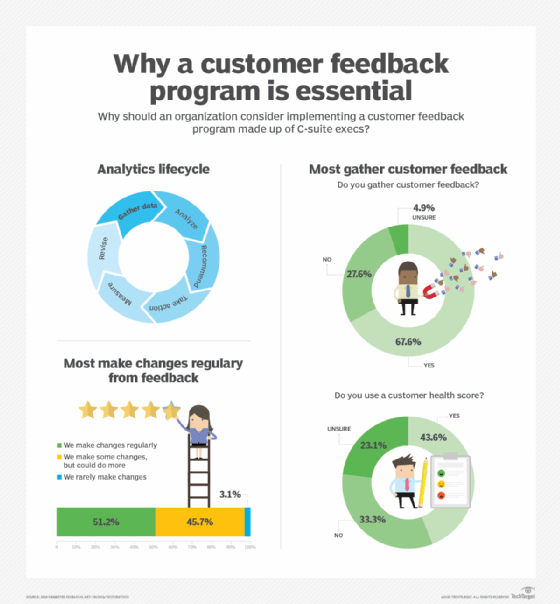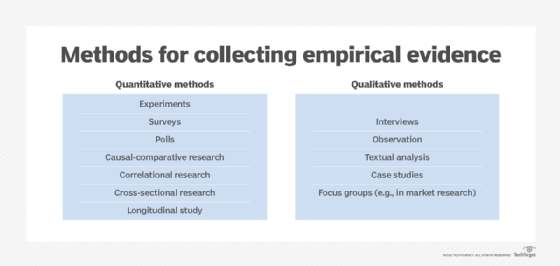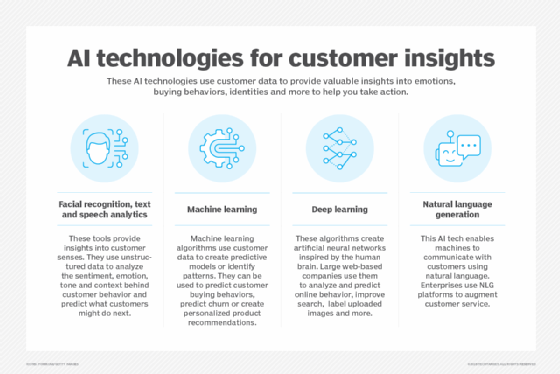What is customer insight (consumer insight)?
Customer insight, or consumer insight, is the understanding and interpretation of customer data, behaviors and feedback into conclusions that can be used to drive actions that improve product development and customer support.
Insights are the actionable motivations behind the wants and needs of customers that can be used to guide the evolution of features, development of new products and creation of consumer benefits. Collecting customer insights attempts to align customers' needs with a company's business goals.
Origins and evolution of customer insight
The roots of customer insight can be traced back to the early days of commerce, but the way we understand and use these insights has changed drastically over the years.
In ancient markets, merchants directly interacted with their customers. This face-to-face interaction provided immediate feedback, allowing sellers to tailor their offerings based on direct consumer reactions. While not termed customer insight back then, this was its most rudimentary form.
The late 19th and early 20th centuries witnessed the birth of formal market research. As businesses grew and markets expanded, companies such as the National Cash Register Company began organizing systematic data collection efforts to understand customer preferences.
The post-World War II era brought about a consumer boom, with businesses witnessing an expanding middle class with disposable incomes. Companies became more consumer-centric, leading to the burgeoning of market research firms dedicated to studying consumer behaviors and preferences.
The evolution continued with the rise of digital platforms, big data and artificial intelligence (AI).With companies leveraging tools such as customer data platforms (CDPs) and machine learning algorithms, they now have the power to analyze larger volumes of data in real time, predict trends and offer hyper-personalized experiences to individual users.
In this era, customer insight has evolved into a blend of traditional techniques and cutting-edge data science, enabling businesses to glean more accurate, actionable insights than ever before.
The importance of customer insight
Customer insights serve as the compass guiding businesses to make informed decisions, evolve their offerings and resonate deeply with their target audience. But what makes these insights so invaluable?
- Strategic decision-making. By delving into the motivations, preferences and pain points of customers, businesses can make strategic decisions that align with market demand. Whether it's launching a new product or pivoting a marketing strategy, insights ensure actions are rooted in data-driven understanding.
- Risk mitigation. Venturing into the unknown can be a costly gamble for businesses. Customer insights act as a safety net, reducing the risks associated with investments, be it in product development or market expansion.
- Enhanced engagement. Understanding customer behavior and preferences helps businesses tailor their messaging, products and services. This personalized approach deepens customer engagement and fosters loyalty.
- Optimized return on investment (ROI). Insights lead to smarter investments. By focusing resources on areas that resonate most with customers, businesses can ensure a better ROI.
- Bridging the expectation-reality gap. Every business aspires to meet, if not exceed, customer expectations. Yet, there's often a chasm between what customers desire and what businesses offer. This is where customer insight can play a pivotal role. Customer insight typically ensures that the voice of the customer is not just heard but acted upon, fostering an ecosystem where both businesses and their customers thrive.

How customer insight differs from market research
Though often used interchangeably, customer insight and market research serve distinct roles. Market research collects raw data on consumer behaviors and preferences, whereas customer insight interprets this data to identify deeper motivations and trends.
For example, while market research might show that a product appeals to a certain demographic, customer insight reveals why that demographic finds the product appealing. This distinction makes customer insight invaluable for crafting targeted strategies that address not only what consumers do, but the reasons behind their choices.
Components and sources of customer insight
Now that we understand customer insights and their importance to a business and its products, let's examine the different channels used to collect customer insights.
Market research
Market research is a foundational component of customer insight. It involves systematic gathering, recording and analyzing of data about customers, competitors and the market. This can include surveys, interviews and observations aiming to understand customer preferences, market trends and competitive positioning. Through market research, businesses can identify market gaps, gauge product demand and better understand their target demographic.
Customer service data
Every interaction a customer has with a company's support or service team is a potential goldmine of insights. Complaints, queries, feedback,and even praises provide invaluable data. This data reveals pain points, product issues and areas of satisfaction or dissatisfaction. Regularly analyzing customer service data ensures that businesses stay attuned to their customers' evolving needs and concerns.
Focus groups
Focus groups are small, diverse groups of individuals whose reactions to new products, services or advertising are studied to predict the response from the wider population. They offer qualitative data that can delve deeply into the reasoning behind certain consumer behaviors or preferences. By discussing and probing in a moderated setting, businesses can gain nuanced insights that might not emerge from quantitative methods alone.
Purchase history
A customer's purchase history is a chronicle of their relationship with a brand or product. By studying patterns in purchasing behaviors, businesses can identify loyal customers, products that are popular or underperforming, and potential upselling or cross-selling opportunities. This historical data, when analyzed effectively, can predict future buying behaviors, helping businesses strategize their marketing and sales efforts more efficiently.
Product reviews
Product reviews, whether they are on a company's website, third-party e-commerce sites, or social media platforms, provide direct feedback from users. Positive reviews can highlight strengths and successful features, while negative reviews can pinpoint areas needing improvement. Importantly, reviews are often the first thing potential customers see, making them crucial for both insights and brand reputation management.
By tapping into these diverse sources, businesses can construct a holistic understanding of their customers. It's not just about collecting data; it's about connecting the dots between different sources to derive actionable and transformative insights.
The process of deriving customer insight
Drawing from the multitude of sources, such as product reviews and market research, isn't an end in itself. The true essence lies in processing this information and interpreting it as a basis for an effective strategy.
Interpretation involves filtering out the noise and focusing on patterns, anomalies and trends. Advanced analytics software and dedicated data science teams work tirelessly to decode this data, ensuring businesses grasp not just the what but also the why behind customer behaviors. This phase is pivotal as actionable strategies are born from well-interpreted data.
Also important is the differentiation between qualitative data (like open-ended feedback from focus groups) and quantitative data (like purchase statistics). Both are integral.
Qualitative data paints a picture of customer sentiments, emotions and motivations. Quantitative data offers measurable, concrete figures to illuminate strategies. A balanced approach, drawing on both forms of data, yields a holistic view of the market.

Having complete customer insights is nice but what matters most is how organizations put them to work. This is where businesses feel the tangible impact of their meticulous data collection and analysis efforts.
- Enhancing product development. Insights can drive innovation. By understanding customer needs and gaps in the current market, businesses are poised to design products that cater precisely to user demands. It's no longer about shooting in the dark but crafting solutions that resonate.
- Refining marketing strategies. Marketing isn't just about visibility but relevance. Armed with customer insights, marketing teams can tailor campaigns that strike a chord. Whether it's choosing the right platform, the perfect messaging or the optimal time to launch, insights help ensure that every marketing dollar is spent wisely.
- Improving customer support and engagement. The customer journey map doesn't end with a purchase. Insights shed light on post-purchase experiences, helping businesses enhance support mechanisms. Moreover, they provide clues on how to keep customers engaged, foster loyalty and ensure repeat business.
The journey from raw data to customer insights is a meticulous one, but its result profoundly shapes businesses. It's about staying in tune with customer needs and evolving dynamically, ensuring both relevance and impact in an ever-shifting market landscape.
Cross-functional benefits of customer insights
While customer insights directly impact product development and marketing, they also benefit other departments, such as sales, customer service and even finance. For example, insights into customer purchasing behavior can help sales teams identify high-potential leads, while customer service teams can use these insights to offer more personalized support.
This cross-functional approach ensures that insights are not siloed within one department but are utilized across the organization to create a unified, customer-centric strategy.
Integrating customer insights with digital marketing
Customer insights have also become essential in optimizing digital marketing strategies. Insights allow businesses to personalize their digital campaigns, tailoring messaging, timing and channels to suit customer preferences. For instance, knowing that a specific audience segment engages more on social media during the evening can lead to strategic scheduling that maximizes engagement.
Additionally, integrating insights with tools like email marketing platforms or social media analytics helps create a seamless, data-driven approach that enhances the customer journey.
Using predictive analytics to anticipate customer needs
Predictive analytics is a powerful complement to customer insights, leveraging historical data to forecast future behaviors and trends. By incorporating predictive models, businesses can anticipate what customers might need or want next, enabling them to stay ahead in the market.
This approach not only strengthens customer loyalty but also positions businesses as proactive problem-solvers, able to adjust offerings before customer demands shift.
The challenges in gathering and using customer insights
While the transformative power of customer insights is undeniable, as evidenced by their influence on product development, marketing strategies and customer engagement, the journey to obtain and use these insights isn't without its hurdles.
One of the foremost challenges is data overload. In an era where every click, like and share can be monitored, businesses can easily drown in a sea of data, struggling to discern what is relevant. Additionally, inconsistencies in data sources and potential biases can skew results, leading to misguided strategies.
Then there's the challenge of rapidly changing consumer behaviors. In today's digital age, trends can shift overnight. What was relevant a month ago might be obsolete today. Keeping up with this pace and ensuring that insights remain timely is a constant challenge.
Furthermore, in the pursuit of insights, the question of data privacy looms large. With regulations like the General Data Protection Regulation (GDPR) in place, businesses must tread carefully, ensuring they respect consumer privacy while gathering data.
It's a delicate balance. Ethical considerations come into play, and businesses need to ensure that their quest for insights doesn't trample over consumer rights. Transparent data collection methods, clear opt-in and opt-out mechanisms, and stringent data protection measures are mandatory.
The future of collecting customer insights
Looking ahead, the world of customer insights is set for evolution. As AI and machine learning become more intertwined with data analysis, the depth and accuracy of insights are bound to increase. Real-time insight will gain prominence, enabling businesses to react dynamically to market shifts.

As consumers are now more conscious of their digital footprint, businesses will also likely need to adopt more transparent, ethical and permission-based data collection methods. The goal is now to gather meaningful data with minimal intrusion.
In summary, in the dance between businesses and their customers, insights are the rhythm. They guide, inform and inspire, ensuring that businesses have a solid foundation for taking actions that can help them stay relevant and thrive in an ever-evolving marketplace.
While challenges abound, so do opportunities. Those businesses able to efficiently collect and synthesize customer insight into strategy, while being mindful to avoid drowning in data and ensure compliance with data privacy rules, will be best poised to excel in this area.
See how to get value from customer insights data and check out customer insights research techniques for your organization. Explore best practices to ensure GDPR compliance and benefits of using big data for businesses.






